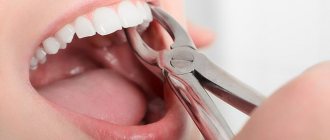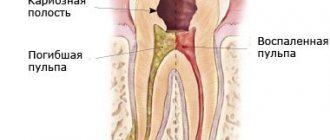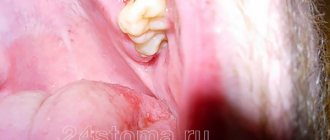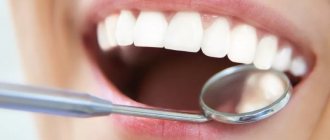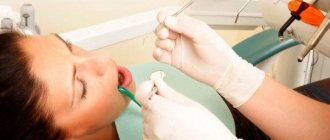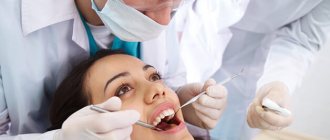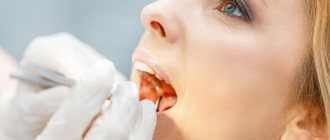Content:
- A tooth has been removed: can you or can’t smoke?
- Why smoking after removal is undesirable
- Is it possible to smoke after tooth extraction if there are stitches on the gums?
- Smoking and anesthesia are an undesirable combination
- Useful information about the effect of nicotine on the mucous membranes of the oral cavity
- How to speed up the healing of a hole
A person who has just had a tooth removed is usually nervous. This is understandable - he has suffered stress and wants to relax. Smokers often use cigarettes to calm down, but the question arises: when can you smoke after dental surgery? We suggest you look into it.
A tooth has been removed: can you or can’t smoke?
Dental surgeons prohibit smoking during the first two to three hours after extraction. This short period is relevant if:
- the operation was not very complicated;
- the bleeding has stopped completely;
- after removing the gauze swab, blood did not begin to flow again;
- a dense blood clot has managed to form, isolating the wound in the gum.
In severe cases, smoking after tooth extraction will have to be postponed for several days - the exact time period will be determined by the doctor. This is due to the fact that nicotine contained in cigarette smoke irritates the edges of the inflamed hole and causes spasm of blood vessels. Because of this, regeneration processes slow down and dangerous complications can develop.
Stages of socket healing after tooth extraction
How to behave after tooth extraction is determined by the characteristics of the restoration processes. Doctors distinguish several stages:
- The first day after tooth extraction surgery. The extraction process is accompanied by tissue damage and rupture of blood vessels, which leads to bleeding. When the socket fills with blood, a thrombus or blood clot forms. It is very important to keep the blood clot intact, as it protects the wound from bacterial microflora and serves as the basis for the formation of new tissue.
- 2-3 days after removal of a chewing tooth. The patient's behavior is aimed at preserving the blood clot and protecting the socket from external injury. At this stage, the formation of connective tissue begins, which is responsible for gum healing.
- A week after tooth extraction. Recovery moves to a new stage - the clot turns white, swelling and pain disappear.
- 10-15 days after an appointment with a dental surgeon. The gums heal, and new bone tissue is actively formed in the cavity of the socket. A routine examination after molar tooth extraction is necessary to monitor the patient’s condition and remove sutures if the hole was sutured.
- The ordering of fibers and further compaction of bone tissue begins in the 3rd month after tooth extraction.
- Due to lack of load, atrophy of the upper part of the bone occurs, which previously served as support for the crown part of the tooth.
What to do next after a chewing tooth has been pulled out depends on the stage of healing of the hole and the dentist’s recommendations.
Why smoking after removal is undesirable
If you start smoking after leaving the dentist's office, you may experience dry socket problems. This means that the blood clot formed to protect the wound from the penetration of pathogens will collapse. Then the tissues will be left without a natural barrier. When smoking further cigarettes and eating food, irritating substances will enter the hole. In this case, there is no hope for quick healing.
The inflammatory process that has developed due to dry socket manifests itself:
- pain at the location of the torn unit;
- increased body temperature;
- accumulation of purulent masses in the wound;
- foul breath.
There is no point in hoping that the situation will normalize on its own. If you have a dry socket, you should visit your dental surgeon again as soon as possible.
Molar tooth extraction: consequences
All consequences after tooth extraction can be divided into pathological and normal. The patient should understand that as a result of the surgical operation, soft tissues, blood vessels, as well as bone structures from which tooth roots are extracted are injured. Therefore, it is impossible to completely avoid pain and discomfort.
Removal can be simple or complex. In the first case, after anesthesia, the dental surgeon carefully pulls out the tooth, leaving a small hole. Simple removal is completed in 5-10 minutes and does not require the use of special tools. Complex extraction is the extraction of a chewing tooth with a branched root system, tortuous roots, as well as traumatized and repeatedly treated units. Extraction (removal) is often accompanied by cutting the gums, dividing the dental crown into several parts for sequential extraction, and using various equipment. An operation of this type takes up to 40-60 minutes. The socket of the extracted tooth is usually sutured for faster healing.
The more complex the work of a dental surgeon, the higher the risk of postoperative complications after tooth extraction. The patient must be able to distinguish between normal and anxiety states.
Normal condition after tooth extraction
The norm after removal is:
- The pain is aching, pulling, throbbing. Passes in 2-4 days.
- Bleeding is residual and completely stops within the first hour after surgery.
- Edema is a small localized swelling that disappears in 2-3 days.
- Temperature - no more than 37.5 degrees. It normalizes in a couple of days.
Symptoms of infection after tooth extraction
The following symptoms indicate the occurrence of a complication after the removal of a front or other tooth:
- temperature over 38 degrees;
- continuous or recurring bleeding;
- increasing swelling;
- increasing pain in the area of the removed unit;
- bad breath;
- pus from the socket;
- enlarged lymph nodes.
Alarm signals from the body indicate infection of the wound, active inflammatory processes, infection after tooth extraction. In this case, the patient urgently needs to see a doctor to determine the cause of the pathology and select treatment.
Smoking and anesthesia are an undesirable combination
Doctors insist that patients do not smoke for the next two to three hours after extraction for good reason. Anesthetics used during dental surgery make the tissue completely insensitive and reduce the activity of some muscles and can change the breathing rate. It is very important to wait until their effect ends.
Nicotine and carbon monoxide entering the oral cavity during smoking a cigarette cause spasm of blood vessels and reduce oxygen saturation in the blood. The combination of all these factors leads to a situation where the tissues of the mouth do not receive enough oxygen, which is important for their restoration.
Useful information about the effect of nicotine on the mucous membranes of the oral cavity
The mucous membranes of the human oral cavity are lined with very delicate and easily vulnerable epithelium. With the systematic use of tobacco products, nicotine and toxic tars damage tissue. The situation is aggravated by the negative impact of elevated temperature when inhaling cigarette smoke.
This is why smokers are often diagnosed with gingivitis and periodontitis. The components present in the smoke change the ligamentous apparatus of the tooth. The gums become inflamed. In the absence of adequate treatment and the persistence of a bad habit, the inflammatory process progresses. Then the unit becomes mobile.
Compounds present in cigarette smoke spasm peripheral blood vessels, disrupt tissue trophism and increase inflammation. Most often, the disease occurs without acute pain and bleeding, so the smoker is in no hurry to see a dentist. But, if you go to the doctor late, you can lose your tooth ahead of time.
How to speed up the healing of a hole
Dentists always give the patient individual recommendations that must be followed. But there are general rules that apply to all patients:
- Do not smoke for at least two to three hours.
- Promptly remove the tampon soaked in antiseptic from the postoperative wound. If you forget to do this, the fabric will become a suitable breeding ground for bacteria.
- Do not touch the blood clot covering the wound. It cannot be picked or felt. The speed of recovery directly depends on the state of the clot.
- When rinsing, do not make intense movements that will help wash out the clot. You just need to put the medicinal solution in your mouth and carefully hold it on the side of the extracted tooth.
- Do not apply medications to the affected area that have not been prescribed by a doctor. Such amateur activities can lead to dangerous complications.
- In the first three days after extraction, do not take a hot bath or steam in a bathhouse or sauna.
- Do not eat until the anesthesia wears off. Otherwise, you may bite the tissue of your cheek or lip.
- Take only those medications prescribed by your dentist. Sometimes doctors decide to prescribe antibiotics - they must be taken strictly according to the specified regimen.
How the regeneration process will proceed depends not only on the actions of the dental surgeon, but also on the behavior of the patient. Remember this!
A tooth was removed: what to do after removal
Removal of the diseased or destroyed unit is completed by applying a gauze pad, which will stop the bleeding and protect the wound from oral bacteria. In difficult situations, the hole is additionally fixed with sutures.
All procedures and recommendations after tooth extraction are divided into general, which are performed by all patients, and private, selected individually. When making appointments, an experienced doctor will take into account concomitant diagnoses, chronic diseases and other health conditions.
What to do after tooth extraction to prevent complications
Doctors from good Moscow dentistry explain in detail what to do next after a molar tooth has been removed:
- Keep the cotton swab applied by the doctor for 20-30 minutes. It is not recommended for longer, since cotton wool soaked in blood is a good basis for the proliferation of microorganisms. And pathogenic microflora can easily cause infection of the hole.
- Apply cold compresses to the cheek in the area where the wound is projected. This is a good prevention of edema. Compresses are effective for the first 2-3 hours after surgery, then they are done only when indicated.
- Mouth baths with antiseptic preparations. Doctors recommend Miramistin and Chlorhexidine 0.5% solutions as the most effective.
- Change your toothbrush. To a new one, sterile, without its own bacterial environment and softer, so as not to injure the gums.
- Drink more warm water. Carefully - from a mug or glass.
What not to do after molar tooth extraction
There is a list of strict restrictions on what you cannot do when a tooth is pulled out. Ignoring these rules can cause serious complications - inflammation, diseases.
Contraindications after tooth extraction include:
- Visiting the sauna, bathhouse. Also, avoid taking a hot bath.
- Mechanical touch to the hole. You should not touch the wound with your tongue, much less with foreign objects.
- Taking aspirin and other blood thinning medications.
- Mouth rinse. Instead, medicinal baths are allowed. The patient takes an antiseptic composition or just water into his mouth and carefully spits it out after some time.
- Active physical activity. Restrictions include hard work and intense sports training.
- Cleaning your mouth with a stiff brush. The ban is imposed for the entire healing period. After the first day, you can and should brush your teeth, but only carefully and using a soft toothbrush.
- Drinking through a straw. Even briefly creating a vacuum can cause the blood clot to fall out and expose the socket.
For the first hours, or better yet 2-3 days, you should also refrain from smoking and drinking alcohol, as this can cause increased bleeding and washout of the blood clot.
If you adhere to all the requirements of what not to do when a tooth is removed, then the risk of complications after surgical treatment is minimal.

